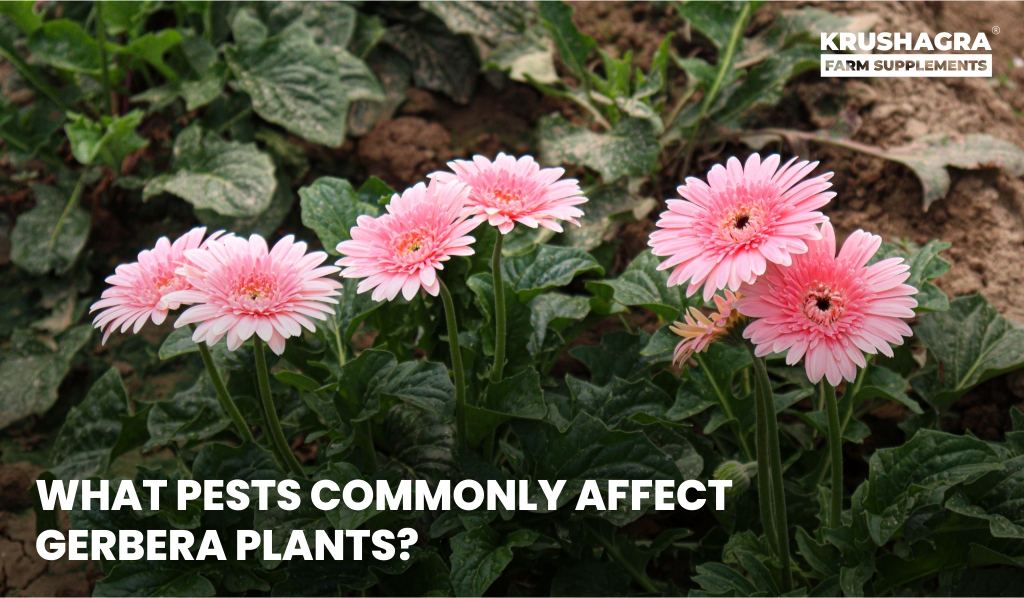Gerbera daisies are a favorite among gardeners and commercial florists, prized for their vibrant, cheerful blooms that add a touch of elegance to any space.
However, like many ornamental plants, gerberas are susceptible to a variety of pests that can damage their leaves, stems, and flowers, affecting their overall health and aesthetic appeal. Identifying and managing these pests is crucial for maintaining thriving gerbera plants.
This comprehensive guide explores the most common pests that attack gerbera plants, the signs of infestation, and effective strategies for control and prevention.
Common Pests That Affect Gerbera Plants
1. Aphids
- Appearance: Tiny, pear-shaped insects in green, black, or yellow.
- Damage: Aphids suck sap from the leaves and stems, causing yellowing, curling, and stunted growth. They also excrete honeydew, which attracts ants and fosters sooty mold.
- Control: Use neem oil, insecticidal soap, or introduce natural predators like ladybugs.
2. Spider Mites
- Appearance: Microscopic arachnids, often red or brown, visible with a magnifying glass.
- Damage: Spider mites feed on the underside of leaves, leaving yellow stippling or a bronze appearance. Severe infestations result in leaf drop and webbing.
- Control: Spray with a strong stream of water, apply miticides, or use sulfur-based sprays.
3. Whiteflies
- Appearance: Tiny, moth-like insects with white wings.
- Damage: Whiteflies suck plant sap, causing leaf wilting, yellowing, and reduced plant vigor. Like aphids, they secrete honeydew that encourages sooty mold.
- Control: Use sticky traps, neem oil, or introduce parasitic wasps.
4. Thrips
- Appearance: Slender, tiny insects with fringed wings, often black or yellow.
- Damage: Thrips puncture flowers and leaves to feed, leading to distorted growth, silver streaks on leaves, and unsightly blooms.
- Control: Remove affected plant parts, or use blue sticky traps.
5. Fungus Gnats
- Appearance: Small, mosquito-like flies that thrive in moist soil.
- Damage: Fungus gnat larvae feed on organic matter and roots, causing poor growth, wilting, and susceptibility to other diseases.
- Control: Reduce watering, use soil drenches with Bacillus thuringiensis (Bt), or apply sticky traps.
6. Mealybugs
- Appearance: White, cottony insects that cluster on stems and leaf nodes.
- Damage: Mealybugs feed on sap, leading to yellowing leaves, wilting, and stunted growth. They also excrete honeydew, fostering mold growth.
- Control: Wipe with alcohol-soaked cotton swabs, apply neem oil, or use predatory insects like mealybug destroyers.
7. Leaf Miners
- Appearance: Larvae of small flies that burrow into leaves.
- Damage: They create winding, white tunnels or blotches on leaves, reducing photosynthesis and plant health.
- Control: Remove affected leaves, use systemic insecticides, or introduce parasitic wasps.
8. Slugs and Snails
- Appearance: Soft-bodied, slimy mollusks often found in damp areas.
- Damage: Slugs and snails feed on leaves and flowers, leaving irregular holes and slime trails.
- Control: Use organic slug pellets, diatomaceous earth, or beer traps to reduce their population.
Signs of Pest Infestation in Gerbera Plants
Look out for the following indicators of pest problems:
- Yellowing, curling, or spotted leaves.
- Visible insects on leaves, stems, or flowers.
- Webbing or sticky residue on plant surfaces.
- Holes in leaves or damaged flowers.
- Wilting or stunted plant growth.
Regular inspection of your gerbera plants is key to early detection and control.
Preventive Measures for Gerbera Plant Pests
Preventing pest infestations is always better than curing them. Here’s how you can protect your gerbera plants:
- Maintain Plant Health: Strong, healthy plants are less susceptible to pests. Provide adequate sunlight, water, and nutrients.
- Proper Watering: Avoid overwatering, as it attracts pests like fungus gnats and encourages diseases.
- Cleanliness: Remove dead leaves, weeds, and plant debris where pests can hide and breed.
- Companion Planting: Grow pest-repellent plants like marigolds and lavender nearby to deter common pests.
- Quarantine New Plants: Inspect and isolate new plants before introducing them to your garden.
- Mulching: Use organic mulch to maintain soil moisture and deter pests like slugs and snails.
Natural and Chemical Control Methods
Natural Methods
- Biological Controls: Introduce beneficial insects such as ladybugs, lacewings, and parasitic wasps.
- Neem Oil and Soap Sprays: Effective against a wide range of pests and safe for beneficial insects.
- Diatomaceous Earth: A natural powder that dehydrates soft-bodied pests like slugs and mealybugs.
Chemical Methods
- Systemic Insecticides: These are absorbed by the plant and kill sap-feeding pests like aphids and whiteflies.
- Miticides: Specialized products for spider mites.
- Slug Baits: Pellets designed to attract and kill slugs and snails.
Always follow the manufacturer’s instructions for safe and effective use of chemical controls.
Importance of Regular Monitoring
Pest populations can grow quickly if left unchecked. Regularly inspecting your gerbera plants ensures early detection, making it easier to manage infestations before they become severe. Use a magnifying glass to spot tiny pests like spider mites and thrips, and check the undersides of leaves where pests often hide.
Let’s Conclude
Gerbera plants, while stunning, are prone to attacks from a variety of pests, including aphids, spider mites, whiteflies, and thrips. Recognizing the signs of infestation and taking timely action is crucial for keeping your plants healthy and vibrant.
By adopting preventive measures, using natural controls, and applying chemical treatments judiciously, you can protect your gerberas and enjoy their bright blooms throughout the season.
A proactive approach to pest management ensures that your garden remains a thriving haven of beauty.
Frequently Asked Questions
What are the most common pests that attack gerbera plants?
Aphids, spider mites, whiteflies, thrips, mealybugs, and fungus gnats are among the most common pests that affect gerbera plants.
How can I tell if my gerbera plant has a pest infestation?
Look for yellowing or curling leaves, webbing, sticky residue, holes in leaves or flowers, and visible insects on the plant.
What natural methods can I use to control pests on gerbera plants?
You can use neem oil, insecticidal soap, introduce beneficial insects like ladybugs, or apply diatomaceous earth to deter pests naturally.
Are chemical insecticides safe for gerbera plants?
Yes, but they should be used as a last resort and applied according to label instructions to avoid harming beneficial insects or causing plant damage.
How can I prevent pests from attacking my gerbera plants?
Maintain plant health, avoid overwatering, remove plant debris, use companion planting with pest-repellent plants, and quarantine new plants before introducing them to your garden.






